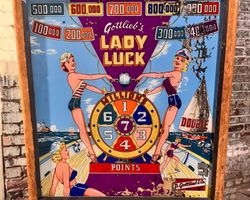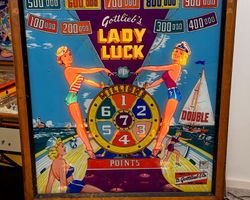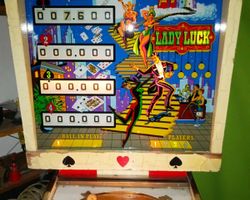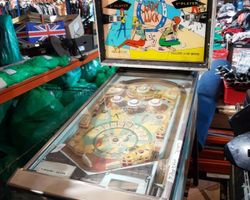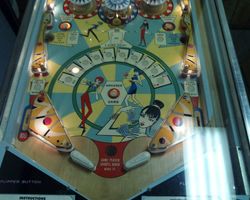Lady Luck
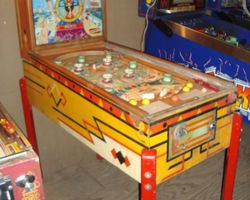
Average Prices: Not enough auctions
Produced: September, 1954
Production Run: 700 units
Machine Type: Electro-mechanical
Players: 1
Design by: Wayne Neyens
Art by: Roy Parker
Pinball machines from the electro-mechanical era possess a distinct character, and among them, Gottlieb's "Lady Luck" stands out as a compelling example of 1950s design and gameplay ingenuity. Released in August 1954, with official Gottlieb documentation noting a September 1954 manufacture date, this single-player game emerged from the prolific D. Gottlieb & Co. factory, a name synonymous with innovation in the burgeoning pinball industry. With a production run of 700 units, "Lady Luck" represented a specific vision for arcade amusement, appealing to players seeking a blend of chance and skill.
At the heart of "Lady Luck's" creation was Wayne Neyens, who contributed not only to the machine’s foundational design but also to its conceptualization, animation, and mechanical engineering. Neyens' holistic involvement ensured a cohesive and deliberate player experience. Complementing his mechanical prowess, the playfield and backglass artwork were crafted by Roy Parker, an artist whose distinctive style brought a vibrant, period-specific aesthetic to Gottlieb machines. Parker's visuals for "Lady Luck," characterized by "period faces" and his signature "Roy Parker girls," contributed significantly to the machine's allure, making it visually appealing alongside its mechanical depth. The collaboration between Neyens and Parker resulted in a machine that was both technically sound and artistically engaging, setting it apart in the mid-1950s pinball landscape.
Signature Features and Design
"Lady Luck" is immediately recognizable as a classic woodrail machine, a construction style prevalent in the era that lent a robust and tangible feel to the gameplay. Its design is defined by a modest but effective set of features: two flippers, four pop bumpers, and three kick-out holes. However, the true signature element of "Lady Luck" lies in its unconventional placement of four gobble holes. Unlike typical gobble holes that might be positioned higher on the playfield to present a hazard, those on "Lady Luck" are situated unusually at the very bottom, effectively serving as outlane rollover switches. This design choice dramatically alters player strategy, transforming what would normally be an immediate loss into a potential scoring opportunity or a path to a replay, creating a distinctive risk-reward dynamic.
The integration of Roy Parker’s artwork across the playfield and backglass is another defining characteristic. The visuals are consistently described as eye-catching and pleasing, encapsulating the aesthetic of the 1950s. This artistic style, combined with the machine's mechanical elements, enhances the overall experience, immersing players in the theme of chance and fortune. While the backglass design has been noted by some as less intricate than other Gottlieb titles, its overall cohesion with the playfield art maintains a unified visual identity, drawing players into the "Lady Luck" narrative.
Playfield and Mechanics
The playfield layout of "Lady Luck," a testament to Wayne Neyens' design philosophy, promotes skillful ball control and nudging. It features a straightforward yet engaging arrangement of elements that invite repeated play. Central to the playfield is a prominent target, often a focal point for direct shots and strategic aiming. The four pop bumpers are distributed to create lively ball action, contributing significantly to the scoring system. Beyond the flippers, posts are strategically placed, enabling players to execute skillful saves and prolong ball time.
The flow of "Lady Luck" is deliberate, encouraging players to master the art of trajectory and rebound. The ball speed is calibrated to feel "just right," allowing for precise flipper work and calculated nudges, which are paramount to navigating the playfield effectively. Unlike later machines that might rely on complex ramps or multi-level playfields, "Lady Luck" achieves player immersion through its elegant simplicity and the direct interaction it demands. The vibrant artwork extends across the entire playfield, from the detailed rollover lanes to the scoring inserts, each element contributing to the game's inviting aesthetic. The lighting, though rudimentary by modern standards, effectively highlights active scoring opportunities and game progression, guiding the player's focus through the various objectives.
Gameplay Dynamics
"Lady Luck" offers a gameplay experience rooted in the mechanical responsiveness of the electro-mechanical era, with a progression system that rewards skillful play and provides multiple pathways to replays. The scoring system heavily emphasizes hitting the pop bumpers, especially when lit, and successfully striking the center target. Unique to "Lady Luck" is its distinctive interaction with the gobble holes at the playfield's base. Instead of universally being a penalty, dropping balls into these specific "outlane" gobble holes can actually be a key strategy for earning replays, providing a nuanced objective often referred to as "drain the ball to win."
Player strategies often revolve around mastering nudging to control ball flow into the lit bumpers and aiming for the center target to advance game features. The presence of multiple rollover switches and kick-out holes ensures that ball trajectories are varied, demanding adaptability from the player. While "Lady Luck" does not feature complex rule sets or multi-stage modes found in modern pinball, its charm lies in its immediate and clear objectives. The distinct sound of bells, often two or three, accompanies significant scoring achievements or replays, providing gratifying auditory feedback that enhances the gameplay highlights. This straightforward yet engaging design ensures that each game of "Lady Luck" presents a dynamic challenge, encouraging players to refine their technique for higher scores and more replays.
Reception and Legacy
"Lady Luck" has garnered an overwhelmingly positive reception within the pinball community, consistently regarded as a classic of the electro-mechanical era and a top-tier woodrail machine. Its strengths are frequently highlighted by enthusiasts who appreciate its fantastic playfield layout, designed for high playability and a precise ball speed that allows for nuanced control. Reviewers often praise the artistic contributions of Roy Parker, citing the eye-catching "period faces" and "Roy Parker girls" as significant aesthetic draws that enhance the game’s visual appeal.
The machine’s engaging features, particularly the multiple ways to earn replays through lit bumpers, points, and its unique gobble hole mechanics, are frequently cited as strong points. The center target challenge and the general focus on skillful nudging and ball control also contribute to its enduring popularity. While some feedback mentions the backglass as "rather mundane" or expresses less enthusiasm for the layout in isolated cases, and a rare report of a non-functioning knocker, these criticisms are minor in contrast to the overall positive sentiment. "Lady Luck" holds a significant place in pinball history, not only as a prime example of Wayne Neyens' early, comprehensive design work but also for its unconventional gobble hole design, which provided an early exploration of outlane mechanics that differed from typical punitive drains. Its legacy is cemented as a highly regarded game that embodies the essence of early pinball's mechanical charm and replay value.
Sponsored Links
 Ebay Listings
Ebay Listings
 Auction Results
Auction Results
| Cost | Location | Date |
|---|---|---|
| USD $3,250 |  Massachusetts, United States Massachusetts, United States |
17 April, 2025 |
| USD $2,900 |  Ohio, United States Ohio, United States |
12 September, 2024 |
| EUR €900 |  Hessen, Germany Hessen, Germany |
09 December, 2021 |
| GBP £361 |  United Kingdom United Kingdom |
01 March, 2020 |
| USD $2,500 |  Pennsylvania, United States Pennsylvania, United States |
31 July, 2019 |
| EUR €1,510 |  Niedersachsen, Germany Niedersachsen, Germany |
27 March, 2019 |
| USD $3,550 |  Pennsylvania, United States Pennsylvania, United States |
03 February, 2017 |
| AUD $1,125 |  Victoria, Australia Victoria, Australia |
11 November, 2014 |
| USD $1,625 |  Ohio, United States Ohio, United States |
14 October, 2013 |
| USD $1,100 |  Michigan, United States Michigan, United States |
26 April, 2013 |


Private Policy · Search Website · Contact Us
As an eBay Partner, we may earn a commission from qualifying purchases made through links on this site, at no additional cost to you.
All trademarks and copyrighted materials remain property of their respective owners. All other content copyright 2007 - 2025 Pinpedia.

